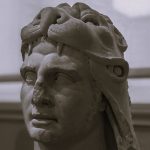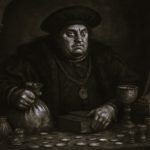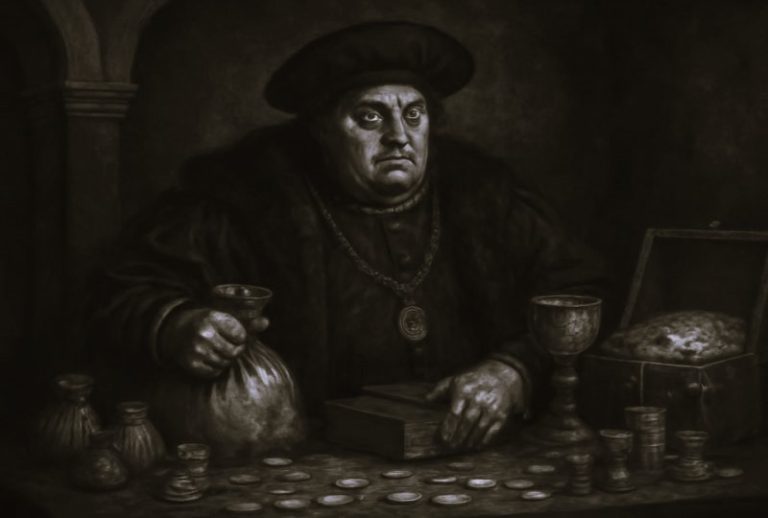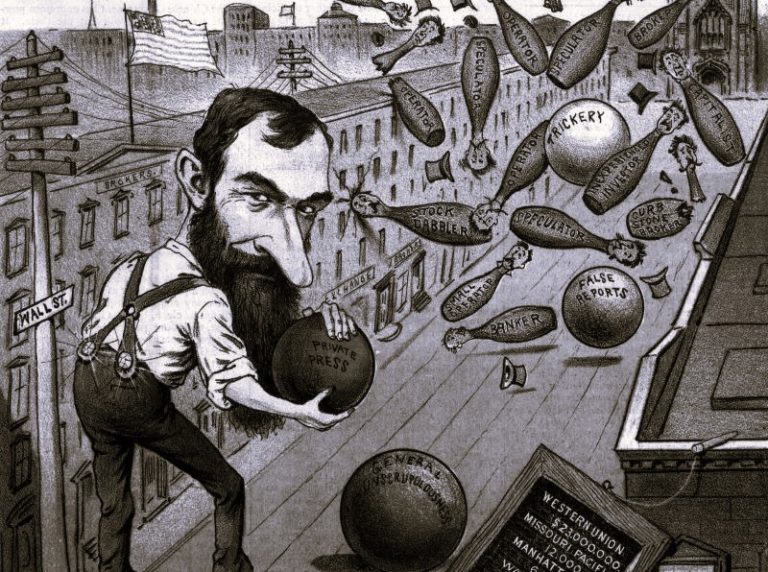
By Dr. Karen Barber
Visiting Assistant Professor of Art History”
The University of Mississippi
Introduction
If we look closely at the cacophony of seemingly random images that make up Hannah Höch’s large-scale photomontage, a cross-section of Weimar Germany’s cultural and political milieu comes into focus. Here, the “Kitchen Knife Dada”—a metaphor for Höch’s careful slicing and dicing—cuts a swath from lower right to upper left, separating Dada and “anti-dada” elements.

Look more closely still, and the image of Kaiser Wilhelm II emerges, standing tall in his imperial finery, looming indignantly over the right half of the composition. Surrounded by disembodied heads and bodies, text fragments, bits of machinery, buildings, maps, and crowds, the Kaiser seems to fade into the background. Elsewhere, women dance, skate, and climb, while men stand at attention or are made to participate, unwittingly, in nonsensical and sometimes violent activities. This densely populated work is difficult, if not impossible, to take in all at once. Though complex, it is worth digging in here to understand the cast of characters and what they tell us about the work and the larger thematics of Berlin Dada.
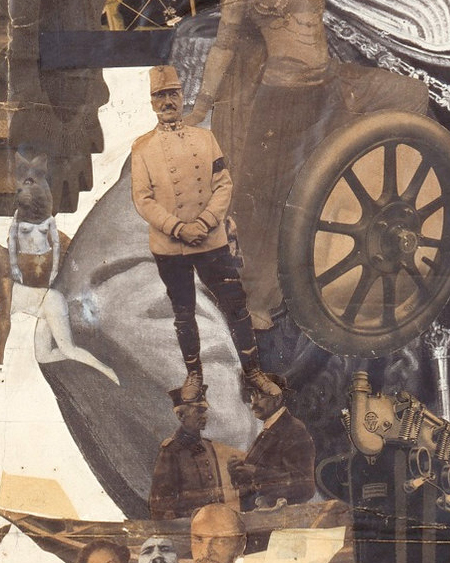
Cut with the Kitchen Knife is a photomontage, made by cutting photographs from mass media publications and pasting them onto a support to create new juxtapositions and new meanings. This is a layered and complex artwork that speaks to the tumultuous moment it was created. As Höch later put it:
“We [the Dadaists] regarded ourselves as engineers, we maintained that we were building things, we said we put our works together like fitters.”[1]
This cut-and-paste aesthetic was wholly embraced by Berlin Dada as a form of political and social critique. The new process allowed the group to comment on the newly established Weimar Republic.

Höch’s Dada sensibility and her status as a “New Woman” (a historical construct, the “New Woman” was understood to be young, independent, often smartly dressed with a short bob hairstyle, eschewing home and family life in favor of joining the workforce) made her work relevant not only to Weimar culture and politics, but also to changing gender roles. While mocking Weimar politicians, Cut with the Kitchen Knife also celebrates women’s victories. A map at lower right indicates the countries where women had the right to vote—a right only recently ratified in Germany with the signing of the new constitution in 1918. In the center of the composition, the head of artist and activist Käthe Kollwitz, taken from a recent newspaper story, attests to her appointment as the first female professor at the Prussian Academy of Arts.
Berlin Dada’s New Woman

Höch had moved to Berlin in 1912, working part-time for Ullstein Verlag—the publisher of Berliner Illustrirte Zeitung (Berlin Illustrated Newspaper) and Die Dame (The Lady—Germany’s equivalent to Vogue). The only woman in the Berlin Dada group, she lived a non-traditional lifestyle that bears similarities to the so-called “New Woman.”

In Weimar Germany, the “New Woman” was the subject of both praise and derision in Berlin’s illustrated press. Her image, which appeared frequently in newspapers and magazines, became fodder for Höch’s photomontages and their celebration of new and expanding roles for women. In Cut with the Kitchen Knife such well-known female figures as Käthe Kollwitz, dancer Niddy Impekoven, and actress Asta Nielsen, are aligned with the Dada axis—from the word “dada” on the upper left to “die große welt dada” (the great Dada world) spelled out at lower right.
Dada’s Berlin Outpost

Dada, which originated in Zurich, Switzerland, embraced the irrational and put forward an iconoclastic “anti-art” ethos, challenging the conditions, consumption, and circulation of art. Dada made its way to Berlin in early 1918 when Richard Huelsenbeck, who was involved in early Dada activities in Zurich, returned to Germany and helped found Club Dada. A raucous provocation to civil society and entrenched traditions in art, the transnational movement (with outposts in Zurich, New York, Berlin, Cologne, Hannover, and Paris) quickly spread. Each Dada group developed its own set of practices.

In Berlin, still reeling from the loss of WWI and the political turmoil and assassinations that followed, Dada took on a decidedly political tone. The Berlin Dadaists embraced a new form of political propaganda in the medium of photomontage. They were especially critical of the artistic and cultural traditions aligned with Wilhelmine Germany (the period of Kaiser Wilhelm II’s rule from 1890 to 1918), which many perceived as the corrupt culture responsible for leading the world into war. The Weimar Republic was founded in 1918 and was soon followed by the Spartacist uprising in early 1919, and the assassinations of Communist leaders Karl Liebnecht and Rosa Luxemburg. Drawing on images from the popular press, Berlin Dada mounted a bitter critique of Weimar politics and culture. Many of the period’s prominent political leaders—Kaiser Wilhelm II, Weimar Republic president Friedrich Ebert, General von Hindenburg, and General Minister of Defense Gustav Noske—can be seen at the upper right of Cut with the Kitchen Knife.
What’s Old Is New Again: Discovering Photomontage

Berlin Dada, which is now synonymous with the new medium of photomontage, made emphatic claims regarding the “discovery” of the medium. The quotation marks around the word “discovery” are intentional. The cut-and-paste technique was, in fact, a popular 19th-century process long used by amateurs to produce photography albums. Höch and her lover (and fellow Dadaist) Raoul Hausmann both claimed to have discovered photomontage in 1918 while vacationing on the Baltic Sea. There they had encountered military mementos in the form of lithographs depicting soldiers in uniform with photographed heads pasted on. This discovery, and the desire to rethink the possibilities of picture-making, prompted them to start making photomontages on their return to Berlin.

With the boom in mass media publications, photography provided a seemingly endless array of images of well-known personalities and politicians to recombine and reconfigure for their biting critiques of Weimar culture.
First International Dada Fair 1920

Cut with the Kitchen Knife was initially shown publicly at the First International Dada Fair in Berlin in 1920. Although hard to believe now, Höch had to fight for the opportunity to show her work in the Dada Fair. Grosz and Heartfield, who organized the Fair along with Hausmann, wanted to exclude her, but Hausmann argued for her inclusion. On entry to the Fair, viewers were bombarded with sights, sounds, and images, including signs and slogans reading “Dada is Political” or “Art is Dead Long Live the Machine Art of Tatlin.” These were intermingled with artworks of varying sizes and shapes hung floor to ceiling, or in the case of John Heartfield and Rudolf Schlichter’s effigy of a German officer with a pig’s head, hanging directly from it.
The group’s new experiments with photomontage dominated at the fair. In his introduction to the catalogue, Wielande Herzfelde explained that “[t]he only program the Dadaists recognize is the duty to make current events, current in both time and place, the content of their pictures.” The source for their new pictures was “the illustrated magazine and the lead stories of the press.”[2]
For Berlin Dada, art was political.
Cutting through Weimar’s Beer-Belly

Höch’s photomontage and its cast of characters is divided, approximately, into four quadrants. The photomontage includes the “anti-dada” contingent at upper right (full of Weimar political figures), and the world of the Dadaists at the lower right. Dada images and text cut diagonally across the picture to the upper left where Albert Einstein proclaims that “dada is not an art trend.” At lower left, images of the masses seem to imply a coming revolution headed by assassinated Communist leader Karl Liebnecht who advises us to “join dada.”

In the Dada section at lower right, we see John Heartfield being bathed by Niddy Impekoven, and the heads of Wieland Herzfelde and George Grosz on the body of a ballerina. Just above, the heads of Dadaist Johannes Baader, Russian leader Vladimir Lenin, and German Communist leader Karl Radek are pasted on the body of another dancer. The open-mouthed face of Raoul Hausmann sits on the body of a deep-sea diver. If we look closely, Höch’s tiny head appears at the upper left corner of a map showing countries with women’s suffrage. At the center of the composition is the headless pirouetting figure of Niddy Impekoven, above which floats the head of famed artist and activist Kollwitz.
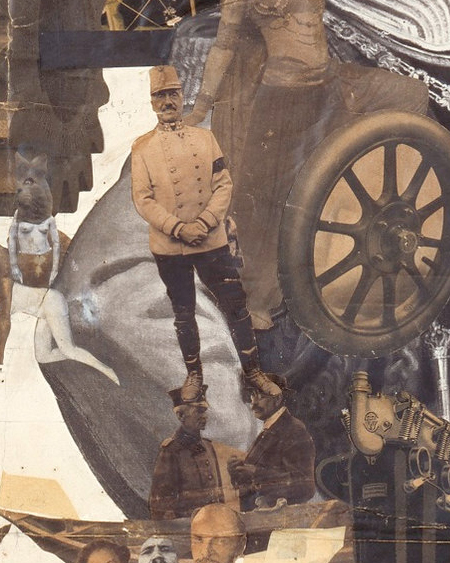
Dada—its calls for revolution, its celebration of technology, popular culture, and the New Women—dominates the composition. It excises Weimar’s Beer-Belly Cultural Epoch and the figures aligned with it. It seems fitting that the instrument used to excise this “fatty flesh” is Höch’s “kitchen knife”—an instrument aligned with women’s work. Women, then, take on an active role in this new Dada world, moving and expressing themselves freely, working to bring on the Dada revolution. As we look again at the image of Kaiser Wilhelm II, looming over the Dada world in his uniform and high-hat, we notice that he has been turned into little more than a plaything (a large wheel at his chest height might make him turn like a child’s toy) or into a distant memory (consumed by the machinery of Berlin Dada, all of which appears to emerge from Raoul Hausmann’s head). Either way he has lost potency thanks to Höch’s deft handling of her kitchen knife.
Appendix
Notes
- Hannah Höch, quoted in The Photomontages of Hannah Höch, Peter Boswell and Maria Makela (Minneapolis: Walker Art Center, 1996), 108–109
- Wieland Herzfelde, “ Introduction,” First International Dada Fair (1920), reprinted in German Expressionism: Documents from the End of the Wilhelmine Empire to the Rise of National Socialism, ed. Rose-Carol Washton Long (Berkeley: University of California Press, 1993), p. 274
Additional Resources
- This photomontage at the Neue Nationalgalerie, Berlin
- Estate of Hannah Höch
- Peter Boswell and Maria Makela, The Photomontages of Hannah Höch (Minneapolis: Walker Art Center, 1996)
- Maud Lavin, Cut with the Kitchen Knife: The Weimar Photomontages of Hannah Höch (New Haven: Yale University Press, 1993)
- Dawn Ades, Photomontage (New York: Thames and Hudson, 1986)
- Leah Dickerman and Brigid Doherty, Dada: Zurich, Berlin, Hannover, Cologne, New York, Paris (Washington [D.C.]: National Gallery of Art in association with Distributed Art Publishers, New York, 2005)
Originally published by Smarthistory, 08.18.2020, under a Creative Commons Attribution-NonCommercial-ShareAlike 4.0 International license.

